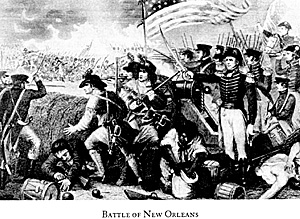
The progress of the peace negotiations influenced the British to continue an operation that General Ross, before his repulse and death at Baltimore, had been instructed to carry out, a descent upon the gulf coast to capture New Orleans and possibly sever Louisiana from the United States. Major General Sir Edward Pakenham was sent to America to take command of the expedition.
BATTLE OF NEW ORLEANS
On Christmas Day, 1814, Pakenham arrived at the mouth of the Mississippi to find his troops disposed on a narrow isthmus below New Orleans between the Mississippi River and a cypress swamp. They had landed two weeks earlier at a shallow lagoon some ten miles east of New Orleans and had already fought one engagement. In this encounter, on December 23, General Jackson, who had taken command of the defenses on December 1, almost succeeded in cutting off an advance detachment of 2,000 British, but after a 3-hour fight in which casualties on both sides were heavy, he was compelled to retire behind fortifications covering New Orleans.
Opposite the British and behind a ditch stretching from the river to the swamp, Jackson had raised earthworks high enough to require scaling ladders for an assault. The defenses were manned by about 3,500 men with another 1000 in reserve. It was a varied group, composed of the 7th and 44th Infantry Regiments, Major Beale's New Orleans Sharpshooters, LaCoste and Daquin's battalions of free Negroes, the Louisiana militia under General David Morgan, a band of Choctaw Indians, the Baratorian pirates, and a motley battalion of fashionably dressed sons and brothers of the New Orleans aristocracy.
To support his defenses, Jackson had assembled more than twenty pieces of artillery, including a battery of nine heavy guns on the opposite bank of the Mississippi.
After losing an artillery duel to the Americans on January 1, Pakenham decided on a frontal assault in combination with an attack against the American troops on the west bank. The main assault was to be delivered by about 5,300 men, while about 600 men under Lt. Col. William Thornton were to cross the, river and clear the west bank.
As the British columns appeared out of the early morning mist on January 8, they were met with murderous fire, first from the artillery, then from the muskets and rifles of Jackson's infantry. Achieving mass through firepower, the Americans mowed the British down by the hundreds. Pakenham and one other general were killed and a third badly wounded. More than 2,000 of the British were casualties; the American losses were trifling.
Suddenly, the battle on the west bank became critical. Jackson did not make adequate preparations to meet the advance there until the British began their movement, but by then it was too late. The heavy guns of a battery posted on the west bank were not placed to command an attack along that side of the river and only about 800 militia, divided in two groups a mile apart, were in position to oppose Thornton. The Americans resisted stubbornly, inflicting greater losses than they suffered, but the British pressed on, routed them, and overran the battery. Had the British continued their advance Jackson's position would have been critical, but Pakenham's successor in command, appalled by the repulse of the main assault, ordered Thornton to withdraw from the west bank and rejoin the main force. For ten days the shattered remnant of Pakenham's army remained in camp unmolested by the Americans, then re-embarked and sailed away.
The British appeared off Mobile on February 8, confirming Jackson's fear that they planned an attack in that quarter. They overwhelmed Fort Bowyer, a garrison manned by 360 Regulars at the entrance to Mobile Harbor. Before they could attack the city itself, word arrived that a treaty had been signed at Ghent on Christmas Eve, two weeks before the Battle of New Orleans.
The news of the peace settlement followed so closely on Jackson's triumph in New Orleans that the war as a whole was popularly regarded in the United States as a great victory. Yet at best it was a draw. American strategy had centered on the conquest of Canada and the harassment of British shipping; but the land campaign failed, and during most of the war the Navy was bottled up behind a tight British blockade of the North American coast.
Back to Table of Contents USAMH Issue 5
Back to US Army Military History List of Issues
Back to MagWeb Magazine List
© Copyright 2005 by Coalition Web, Inc.
This article appears in MagWeb.com (Magazine Web) on the Internet World Wide Web.
Other articles from military history and related magazines are available at http://www.magweb.com